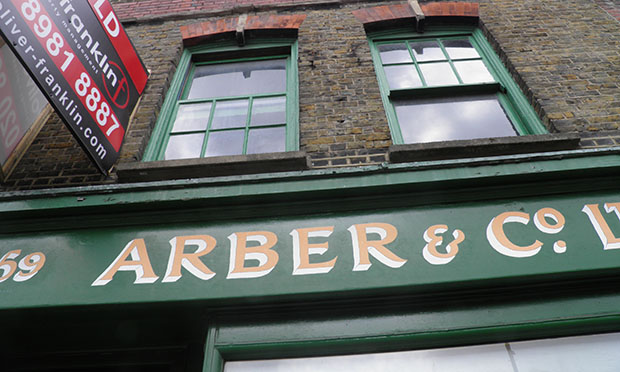Fetishising East London's past
Before moving to London, I watched David Lynch’s The Elephant Man and recognised his flickering Whitechapel freak-show dream-reel as something called the old East End. I didn’t spot it by extant landmarks. Instead, the old East End seemed to emerge from a well-worn confection of signifiers: smog, crowding, cobblestones, Cockney chatter, grinning bawds and ill-shod, street-smart beggar kids.
Lynch was tapping into an accumulated reservoir of fetishistic representations of the East End’s grit and squalor. There are countless variations on the theme, enough to comfortably accommodate both Jack the Ripper and Call the Midwife.
There is, it seems, an enduring hunger for an imagined old East End. In the context of modern British ‘keep calm’ retromania – the glinting flotsam of the jubilee flotilla – this doesn’t seem out of place. But the lure of East London’s memories seems very particular, and more powerfully mythic than the wistful patriotism of bunting-and-cake nostalgia.
I wondered whether the fervour for remembering was a sympathetic response to East London’s history of trauma, which is deep and perhaps unechoed in the rest of the city.
In a Poplar pie and mash shop with tiled walls and framed pictures of pre-war East India Dock Road I meet Ian Porter, a London tour guide and historical novelist. East End poverty, degradation and destruction might be the stuff of popular fascination, he tells me, but they don’t completely explain it. After all, Southeast London’s history was similarly traumatic. Bermondsey was a slum-scape and dumping ground for the city’s unsavoury industries – tanneries, slaughterhouses, soap works, breweries – and took an almost equally heavy beating in the World Wars. “But go into any library,” Porter says, “and there will be twenty books about the old East End. There won’t be any on Bermondsey.”
The crucial divergence is, according to Porter, that Victorian Whitechapel, not Bermondsey, formed the backdrop for the murders, which drew the gaze of the British literary and political classes towards urban poverty. “Nowadays you have all these tacky tours,” says Porter, “Actually, Jack the Ripper had a huge effect. Until 1888 no politicians would come down here. But now, the papers weren’t just covering the murders, they were covering the squalor, the poverty, the prostitution too. The East End becomes the template, if you like.”
Sensational newsprint quickly gave way to fiction as conduit for the consumption of the East End’s savagery. Arthur Morrison’s novel A Child of the Jago, which narrated the moral descent of a Shoreditch slum boy towards violent death at 17, was a bestseller in 1896. The East End was being reconstructed in the reading public’s imagination as an urban wasteland of moral rot, an ‘other’ repository for their social anxieties.
The Victorians’ macabre preoccupations have wound their way into the bank of stereotype, which lend Lynch’s oblique visuals that unexpected connotative eloquence. The distancing effect of passing time has polished the horror into the sort of shadowy glamour commodified by the Ten Bells in Shoreditch, a pub famous for hosting the Ripper’s victims. Porter thinks the East End’s grisly historic reputation – from Ripper to Kray twins – underpins East London’s trendiness. “It’s that edgy charm,” he explains.
Edgy charm aside, memory is an identity-building project and not a static commodity. In today’s East End, this process is not only socially significant, but necessarily fractured, devolved and continuous. Established cultural signifiers can be endowed with new meaning. So the old East End – still cobbled, still gas-lit – can be code for hard working people, community and resilience in the face of bombardment, at the same time as it is the memory of urban degradation and corruptive poverty.
Rupture and change make us want to tell stories afresh. Every new building between old ones is a manifestation of absence, a gap in the architectural record, which demands explanation. A gap in a different record inspired Tabitha Stapely, leader of a resident’s association concerned with the regeneration of Roman Road.
Finding meagre archival data for Bow, she started to dig for stories that would frame the locality’s historic character. “Bow is about pioneers and radicalism, rule-breakers,” Stapely says. “Poverty attracts the social changers.” Stapely drafted the programme of July’s inaugural Roman Road festival to reflect the historic identity she sees there. Walks trailed Sylvia Pankhurst’s suffragette legacy through familiar streets, talks explored the Matchstick Rebellion and the Cable Street anti-fascists, and, in a local cafe, Bow’s elderly denizens shared their direct experience of a fading East End.
We have less and less access to direct experience of the wartime East End, says Stapely. The festival took place the same week that Gary Arber, of W.F. Arber & Co printing works on Roman Road vacated the premises. I met Arber, the octogenarian grandson of the company’s founder, and final custodian of the shop’s 117-year legacy, about a year ago.
He was in blue coveralls, and the shop was a relic in disarray – paper stacked ceiling high, walls chequered with wooden pigeonholes, the counter studded with the tacks and staples of ages. I told him I felt like I had stepped back in time. He told me he liked to time travel, too: with cotton stuffing his ears against the sound of motors, a hurricane lamp for light and a book of collected Victorian news bulletins open across his knees.
The encounter had a melancholy feeling. Perhaps it was because I thought he was seeking refuge in a time of beginnings, before the printing works was living history. Perhaps I was just dizzied by the looping circularity of the memory game. Indeed, as Arber and his printing press left the Roman Road, I found that in my own imagined picture-book of the old East End, with dockers and pie shops, pearly kings and kids playing in the bombed-out rubble, the shops all look a little more like his.

